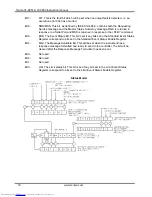
Tenma 72-6851 & 72-6853 Instruction manual
GPIB Subsets
This instrument contains the following IEEE 488.1 subsets:
Source Handshake
SH1
Acceptor Handshake
AH1
Talker T6
Listener L4
Service Request
SR1
Remote Local
RL1
Parallel Poll
PP1
Device Clear
DC1
Device Trigger
DT0
*
Controller C0
Electrical Interface
E2
*
Although no Device Trigger capability is included, the GET message will not cause a
command error unless its position in the input stream dictates that it should; e.g. buried
inside a <PROGRAM MESSAGE UNIT>.
GPIB IEEE Std. 488.2 Error Handling
The IEEE 488.2
UNTERMINATED
error (addressed to talk with nothing to say) is handled as follows.
If
the instrument is addressed to talk
and
the response formatter is inactive
and
the input queue
is empty
then
the
UNTERMINATED
error is generated. This will cause the Query Error bit to be set
in the Standard Event Status Register, a value of 3 to be placed in the Query Error Register and
the parser to be reset. See the Status Reporting section for further information.
The IEEE 488.2
INTERRUPTED
error is handled as follows.
If
the response formatter is waiting to
send a response message
and
a
<PROGRAM MESSAGE TERMINATOR>
has been read by the parser
or
the input queue contains more than one END message
then
the instrument has been
INTERRUPTED
and an error is generated. This will cause the Query Error bit to be set in the
Standard Event Status Register, a value of 1 to be placed in the Query Error Register and the
response formatter to be reset thus clearing the output queue. The parser will then start parsing
the next
<PROGRAM MESSAGE UNIT>
from the input queue. See the Status Reporting section for
further information.
The IEEE 488.2
DEADLOCK
error is handled as follows.
If
the response formatter is waiting to send
a response message
and
the input queue becomes full
then
the instrument enters the
DEADLOCK
state and an error is generated. This will cause the Query Error bit to be set in the Standard
Event Status Register, a value of 2 to be placed in the Query Error Register and the response
formatter to be reset thus clearing the output queue. The parser will then start parsing the next
<PROGRAM MESSAGE UNIT>
from the input queue. See the Status Reporting section for further
information.
GPIB Parallel Poll
The power supplies offer complete parallel poll capabilities. The Parallel Poll Enable Register is
set to specify which bits in the Status Byte Register are to be used to form the
ist
local message
The Parallel Poll Enable Register is set by the
∗
PRE <nrf> command and read by the
∗
PRE?
command. The value in the Parallel Poll Enable Register is ANDed with the Status Byte Register;
if the result is zero then the value of
ist
is 0 otherwise the value of
ist
is 1.
The instrument must also be configured so that the value of
ist
can be returned to the controller
during a parallel poll operation. The instrument is configured by the controller sending a Parallel
Poll Configure command (PPC) followed by a Parallel Poll Enable command (PPE). The bits in
the PPE command are shown below:
bit 7 =
X don't care
www.tenma.com
15
electronic components distributor
















































